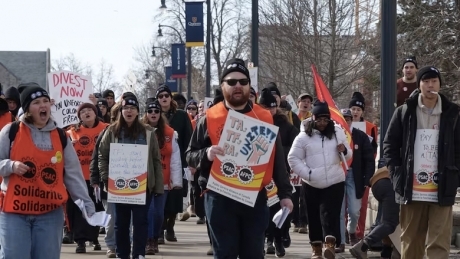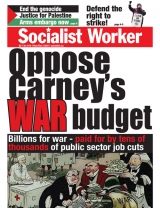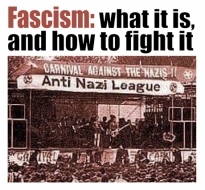Reports
You are here
Graduate workers' strike at Queen’s University: a milestone in the growing resistance against austerity

April 27, 2025
We have entered a period in so-called Canada—and broadly in North America—where campus politics, including student activism and labour action, are under a triple attack. On one hand, universities are being financially re-disciplined through austerity measures that trim or slash “unprofitable” fields of study, particularly in the Arts and Humanities. On the other hand, critical knowledge production is being politically re-disciplined through a clampdown on Palestinian solidarity movements and trans liberation struggles. This new mode of governance in higher education not only seeks to suppress these movements but also aims to “dry the swamp” by penalizing academic support for them within faculty associations and graduate worker unions. The goal is to further delegitimize and marginalize anti-colonial and anti-transphobic activism.
While universities face this two-pronged attack, Ontario’s colleges are undergoing restructuring driven by a new wave of anti-migrant politics targeting international students—whose billions have funded the sinking higher education system for the past two decades. This same migrant population is now being scapegoated for the cost-of-living crisis, targeted by divisive racism under the banner of “Canada First.”
PSAC 901, the graduate workers’ union at Queen’s University in Kingston, Ontario, representing over 2,000 Teaching Assistants, Research Assistants, and Teaching Fellows, went on strike under these conditions. It was the first-ever strike by academic labour on Queen’s campus. With over a quarter of its members being migrant graduate workers, the union’s demands reflected the deepening financial distress faced by master’s and PhD student workers across the board.
The bargaining team put critical demands on the table over six months ago, including tuition minimization, affordable housing commitments, a fair funding-to-labour ratio, a healthy support fund, access to the university-run childcare plan, and remedies for the unconstitutional Bill 124. (Ontario’s public sector wage control law that was overturned by the courts.)
University bosses are just like all other bosses
As these demands were negotiated, the university administration repeatedly drew its red lines, refusing to bargain in good faith or address anything beyond hourly wage increases. When the strike began on March 10, university executives immediately launched an anti-strike campaign, portraying graduate workers as greedy, spoiled, temporary/part-time, and negotiating in bad faith. On the third day of the strike, Queen’s university administration announced its refusal to divest from the ongoing genocide, claiming it would be merely symbolic. Using two private security companies, the employer surveilled the strike closely and aggressively, following picketers into washrooms, wellness centres, prayer rooms, and even off-campus locations.
Despite these pressures, the PSAC 901 picket line held firm. Workers built a united front daily against the employer’s lies, divisive tactics, and heavy policing.
Picketers distributed thousands of flyers countering the university’s misinformation, working to build solidarity with undergraduate students and faculty members.
Unfortunately, we were unable to halt exams or prevent faculty from scraping syllabi and re-weighting grades. The employer wielded its austerity stick to tame faculty members. Despite a powerful solidarity letter from faculty in the second week and a joint rally, we could not mobilize the majority of faculty behind the strike. Similarly, while thousands of undergraduates signed a petition urging the employer back to the table, we could not exert enough economic pressure—such as a united demand for tuition refunds for under-taught and unfairly assessed courses.
Wage gains and childcare funding
Amid this ebb and flow of solidarity and isolation, the picket line stayed strong. It encouraged every member to take on strike duties and resisted security encroachments daily to create safe spaces for Palestinian members, migrant students, and gender-diverse picketers. We have won childcare funding of $110,000, a wage rise 3% this year and then 2.25% in each of the following two years. The wage increase includes a market-adjustment of 12.8% and stronger language for protection for the non-labour portion of graduate student funding. These wins are far from satisfactory. However, the slim content of the new collective agreement cannot be a reason for demoralization among our ranks. Beyond its monetary wins, the picket line has been described as a school with life-long lessons by the picketers.
Lessons from the strike
The six-week strike at Queen’s University exposed the stark class divide on campus. The CEOs—Principals, Provosts, Faculty Deans—of these so-called public institutions are determined to protect their own interests and class privileges, even if it means throwing workers and students under the bus. We saw clearly that higher education governance in Canada operates in layers—from the federal government to the provinces, down to the boardrooms of individual institutions—trickling the burden of crisis onto those at the bottom. This governance also capitulates to the oppressive political climate shaped by the strong winds blowing from the U.S. Every local fight must be seen as part of a broader struggle, and we must develop new forms of sectoral solidarity between workers at post-secondary institutions, and cooperation against our shared adversary.
The one-and-a-half-month-long strike showed that the battles ahead will be hard—but that mass student-worker resistance is possible. The strike experience instilled pride in the picketers and fear in the university’s leadership. That is the victory we will build upon in future waves of struggle. What we need now is a broad anti-austerity campaign in higher education, one that parallels the ongoing collective fight in the healthcare sector.
While anger rises among the precarious academic and non-academic labour force in higher education, employers are refining their divide-and-rule tactics. They are also reviving their "red scare" playbook, targeting anyone who condemns their complicity in the imperial and colonial structures of the current capitalist system.
With these lessons in mind, we must tirelessly re-educate our ranks, recruit a broader layer of labour leaders into the union movement, and organize our sectoral battles—always remembering their global and continental context.
Section:










